
Anacapa Island is a small volcanic island located about 11 miles (18 km) off the coast of Port Hueneme, California, in Ventura County. The island is composed of a series of narrow islets 6 mi (10 km) long, oriented generally east–west and 5 mi (8 km) east of Santa Cruz Island. The three main islets, East, Middle and West Anacapa, are collectively known as The Anacapas by some authors. All three islets have precipitous cliffs, dropping off steeply into the sea.

The Channel Islands are an eight-island archipelago located within the Southern California Bight in the Pacific Ocean, off the coast of California. The four Northern Channel Islands are part of the Transverse Ranges geologic province, and the four Southern Channel Islands are part of the Peninsular Ranges province. Five of the islands are within the Channel Islands National Park, and the waters surrounding these islands make up Channel Islands National Marine Sanctuary. The Nature Conservancy was instrumental in establishing the Channel Islands National Marine Sanctuary. The islands were inhabited as early as 13,000 years ago, the earliest paleontological evidence of humans in North America. They are the easternmost islands in the Pacific Island group.

Channel Islands National Park consists of five of the eight Channel Islands off the Pacific coast of the U.S. state of California. Although the islands are close to the shore of the densely populated state, they have been relatively undeveloped. The park covers 249,561 acres (100,994 ha), of which 79,019 acres (31,978 ha) are federal land. The Nature Conservancy owns and manages 76% of Santa Cruz Island, the largest of the eight.
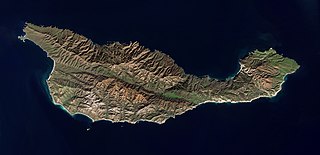
Santa Cruz Island is located off the southwestern coast of Ventura, California, United States. It is the largest island in California and largest of the eight islands in the Channel Islands archipelago and Channel Islands National Park. Forming part of the northern group of the Channel Islands, Santa Cruz is 22 miles (35 km) long and 2 to 6 miles wide with an area of 61,764.6 acres (249.952 km2).
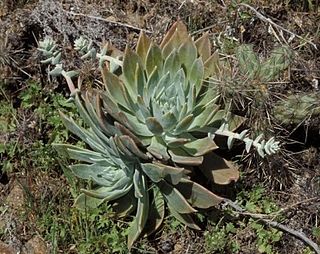
Dudleya traskiae is a rare succulent plant known by the common name Santa Barbara Island liveforever. This Dudleya is endemic to Santa Barbara Island, one of the Channel Islands of California, where it grows on rocky bluffs. The plant has a basal rosette of flat, spade-shaped fleshy leaves up to 15 centimeters long, which are pale green to yellowish. It erects tall stems bearing dense, rounded inflorescences of many bright yellow flowers.
Erysimum teretifolium is a species of Erysimum known by the common names Santa Cruz wallflower and Ben Lomond wallflower. It is a very rare plant endemic to Santa Cruz County, California, where it grows on inland sand spits, chaparral, and sandstone deposits in the southern Santa Cruz Mountains. It is a California state and federally listed endangered species.

Galium buxifolium is a rare species of flowering plant in the coffee family known by the common names box bedstraw and island bedstraw. It is endemic to the Channel Islands of California, where it is known from about 26 populations on two of the islands. It is a federally listed endangered species of the United States.
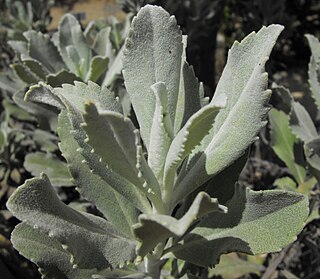
Hazardia detonsa is a rare species of shrub in the family Asteraceae known by the common name island bristleweed. It is endemic to the Channel Islands of California, having been found on 4 islands.

Crocanthemum greenei is a rare species of flowering plant in the rock-rose family known by the common name island rush-rose. It is endemic to the Channel Islands of California, where it grows in the chaparral of the rocky seaside slopes. It is present on three of the eight islands, where it has historically been threatened by feral herbivores such as the Santa Cruz sheep and is making a gradual recovery. It is a federally listed threatened species.
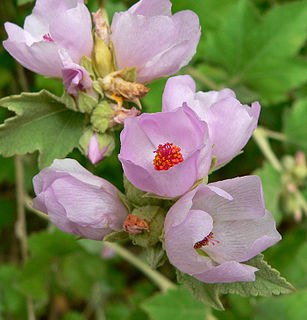
Malacothamnus fasciculatus, with the common name chaparral mallow, is a species of flowering plant in the mallow family. It is found in far western North America.
Malacothrix indecora is a rare species of flowering plant in the family Asteraceae known by the common name Santa Cruz Island desertdandelion. It is endemic to the Channel Islands of California, where it is known from only a few populations on three of the eight islands. As of 2000, there were three occurrences on San Miguel Island, two on Santa Rosa Island, and one on Santa Cruz Island. It grows on the bluffs and rocky coastal grasslands of the islands. Like many Channel Islands endemics, this plant is naturally limited in distribution and has been threatened by the presence of destructive introduced mammals, in this case, feral pigs. The plant became a federally listed endangered species in 1997. This is a mat-forming annual herb which spreads low to the ground no more than about 10 centimeters high. The fleshy leaves have dull lobes. The inflorescence is an array of flower heads lined with oval-shaped phyllaries. The ray florets are under a centimeter long and yellow in color.

Orcuttia californica is a rare species of grass known by the common name California Orcutt grass.

Ribes thacherianum, with the common name Santa Cruz gooseberry, or Santa Cruz Island gooseberry, is a rare North American species of currant found only on one island off the coast of California.

Sibara filifolia, the Santa Cruz Island winged rockcress or Santa Cruz Island rockcress, is a rare species of flowering plant in the family Brassicaceae. It is endemic to the Channel Islands of California, where it is now known from a few occurrences on San Clemente Island and one population on Catalina Island.

Thysanocarpus conchuliferus is a rare species of flowering plant in the mustard family known by the common name Santa Cruz Island fringepod. It is endemic to Santa Cruz Island, one of the Channel Islands of California, where has been recently observed at only one location; some years it is totally absent.
Malacothrix junakii is a rare species of flowering plant in the family Asteraceae known by the common names Anacapa Island desert-dandelion, Junak's desertdandelion, and Junak's malacothrix. It is endemic to Anacapa Island, one of the Channel Islands of California, where it is known from just two occurrences. It occurs in the coastal scrub of the island. It was described to science as a new species in 1997.
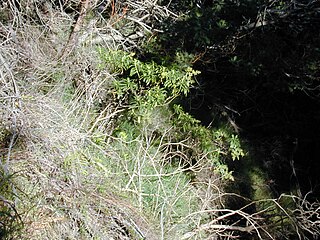
Dubautia plantaginea is a rare species of flowering plant in the aster family known by the common name plantainleaf dubautia. It is endemic to Hawaii where it is the only member of the silversword alliance that is found on all six of the largest islands. Two of the three subspecies are rare and endangered. Like other Dubautia this plant is called na`ena`e.
Melicope munroi is a rare species of flowering plant in the family Rutaceae known by the common names lanahale and Munro's pelea. It is endemic to Hawaii, where it is known only from the island of Lanai. It is a federally listed endangered species of the United States. Like other Hawaiian Melicope, this species is known as alani.

Polyphylla barbata is a rare species of beetle known by the common name Mount Hermon June beetle. It is endemic to California, where it occurs only in Santa Cruz County. There is only a single occurrence of the beetle on a stretch of territory of under 1,500 acres (6.1 km2). This is a federally listed endangered species of the United States.
The wildlife of the Channel Islands of California is wide and diverse, including many endemic species. While the land wildlife is slightly limited, there being only one large, naturally predatory, and native mammal, the small island fox, marine life can include anything from kelp forests to great white sharks.
















